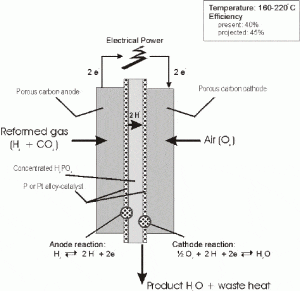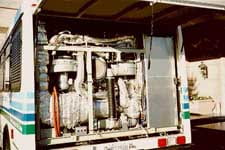The information on this page was prepared by:
| Daniel Marsh | marshd@usc.edu | Computer Science |
| Nick Firdaus Mohd Husin | mohdhusi@usc.edu | Electrical Engineering |
Introduction
The Phosphoric Acid Fuel Cell (PAFC) is the most mature fuel cell technology in terms of system development and commercialization activities. It has been under development for more than 20 years and has received a total worldwide investment in the development and demonstration of the technology in excess of $500 million. The PAFC was selected for substantial development a number of years ago because of the belief that, among the low temperature fuel cells, it was the only technology which showed relative tolerance for reformed hydrocarbon fuels and thus could have widespread applicability in the near term.
Technology
Figure 2: http://voltaicpower.com/FuelCell/pafc.htm (11/20)
At the anode, hydrogen is split into two hydrogen ions (H+), which pass through the electrolyte to the cathode, and two electrons which pass through the external circuit (electric load) to the cathode. At the cathode, the hydrogen, electrons and oxygen combine to form water. The formation of carbon monoxide (CO) around electrodes can “poison” a fuel cell. One advantage of PAFC cells is that at 200 degrees C they tolerate a CO concentration of about 1.5 percent. Another advantage is that concentrated phosphoric acid electrolyte can operate above the boiling point of water, a limitation on other acid electrolytes that require water for conductivity.
Hydrogen for the fuel cell is extracted from a hydrocarbon fuel in an external reformer. If the hydrocarbon fuel is gasoline, sulfur must be removed or it will damage the electrode catalyst. Efficiencies of PAFCs average 40 to 50 percent, but this can rise to about 80 percent if the waste heat is reused in a co-generation system. PAFCs of up to 200 KW capacity are in commercial operation, and units of 11 MW capacity have been tested.
Application
The transit industry is faced with meeting stringent bus emission standards that are increasingly more difficult to meet with diesel technology. Fuel cells offer near zero emissions and significant reductions in gree nhouse gas emissions, as well as potentially more efficient power generation, improved reliability, and lower maintenance costs.
nhouse gas emissions, as well as potentially more efficient power generation, improved reliability, and lower maintenance costs.
30-foot Fuel Cell transit bus on a test drive in Washington, District of Columbia (Georgetown University)
Figure 3 & 4: http://www.fta.dot.gov/research/equip/buseq/fucell/fucell.htm
 H-Power, Georgetown University , and the U.S. Department of Energy adapted a 50 kw Fuji Electric PAFC for transit buses (photo at left), and began running these buses in 1994. Four years later, Georgetown, Nova BUS, and the U.S. Department of Transportation began tests on a bus powered by a 100 kw PAFC from International Fuel Cells Corporation (a joint venture of Toshiba and United Technologies). PAFCs currently require an extended warm-up period, however, so their usefulness in private cars remains limited.
H-Power, Georgetown University , and the U.S. Department of Energy adapted a 50 kw Fuji Electric PAFC for transit buses (photo at left), and began running these buses in 1994. Four years later, Georgetown, Nova BUS, and the U.S. Department of Transportation began tests on a bus powered by a 100 kw PAFC from International Fuel Cells Corporation (a joint venture of Toshiba and United Technologies). PAFCs currently require an extended warm-up period, however, so their usefulness in private cars remains limited.